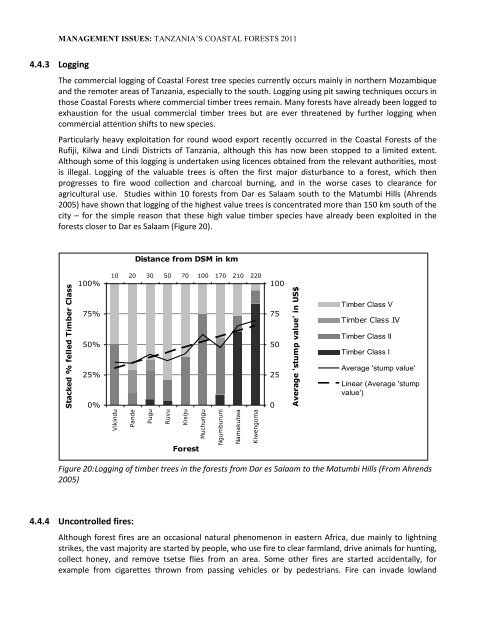Neil D. Burgess, Paul Harrison, Peter Sumbi, James Laizer, Adam ...
Neil D. Burgess, Paul Harrison, Peter Sumbi, James Laizer, Adam ...
Neil D. Burgess, Paul Harrison, Peter Sumbi, James Laizer, Adam ...
Create successful ePaper yourself
Turn your PDF publications into a flip-book with our unique Google optimized e-Paper software.
Vikindu<br />
Pande<br />
Pugu<br />
Ruvu<br />
Kisiju<br />
Muchungu<br />
Ngumburuni<br />
Namakutwa<br />
Kiwengoma<br />
Stacked % felled Timber Class<br />
Average 'stump value' in US$<br />
MANAGEMENT ISSUES: TANZANIA’S COASTAL FORESTS 2011<br />
4.4.3 Logging<br />
The commercial logging of Coastal Forest tree species currently occurs mainly in northern Mozambique<br />
and the remoter areas of Tanzania, especially to the south. Logging using pit sawing techniques occurs in<br />
those Coastal Forests where commercial timber trees remain. Many forests have already been logged to<br />
exhaustion for the usual commercial timber trees but are ever threatened by further logging when<br />
commercial attention shifts to new species.<br />
Particularly heavy exploitation for round wood export recently occurred in the Coastal Forests of the<br />
Rufiji, Kilwa and Lindi Districts of Tanzania, although this has now been stopped to a limited extent.<br />
Although some of this logging is undertaken using licences obtained from the relevant authorities, most<br />
is illegal. Logging of the valuable trees is often the first major disturbance to a forest, which then<br />
progresses to fire wood collection and charcoal burning, and in the worse cases to clearance for<br />
agricultural use. Studies within 10 forests from Dar es Salaam south to the Matumbi Hills (Ahrends<br />
2005) have shown that logging of the highest value trees is concentrated more than 150 km south of the<br />
city – for the simple reason that these high value timber species have already been exploited in the<br />
forests closer to Dar es Salaam (Figure 20).<br />
Distance from DSM in km<br />
100%<br />
10 20 30 50 70 100 170 210 220<br />
100<br />
75%<br />
50%<br />
25%<br />
0%<br />
75<br />
50<br />
25<br />
0<br />
Timber Class V<br />
Timber Class IV<br />
Timber Class II<br />
Timber Class I<br />
Average 'stump value'<br />
Linear (Average 'stump<br />
value')<br />
Forest<br />
Figure 20: Logging of timber trees in the forests from Dar es Salaam to the Matumbi Hills (From Ahrends<br />
2005)<br />
4.4.4 Uncontrolled fires:<br />
Although forest fires are an occasional natural phenomenon in eastern Africa, due mainly to lightning<br />
strikes, the vast majority are started by people, who use fire to clear farmland, drive animals for hunting,<br />
collect honey, and remove tsetse flies from an area. Some other fires are started accidentally, for<br />
example from cigarettes thrown from passing vehicles or by pedestrians. Fire can invade lowland

















